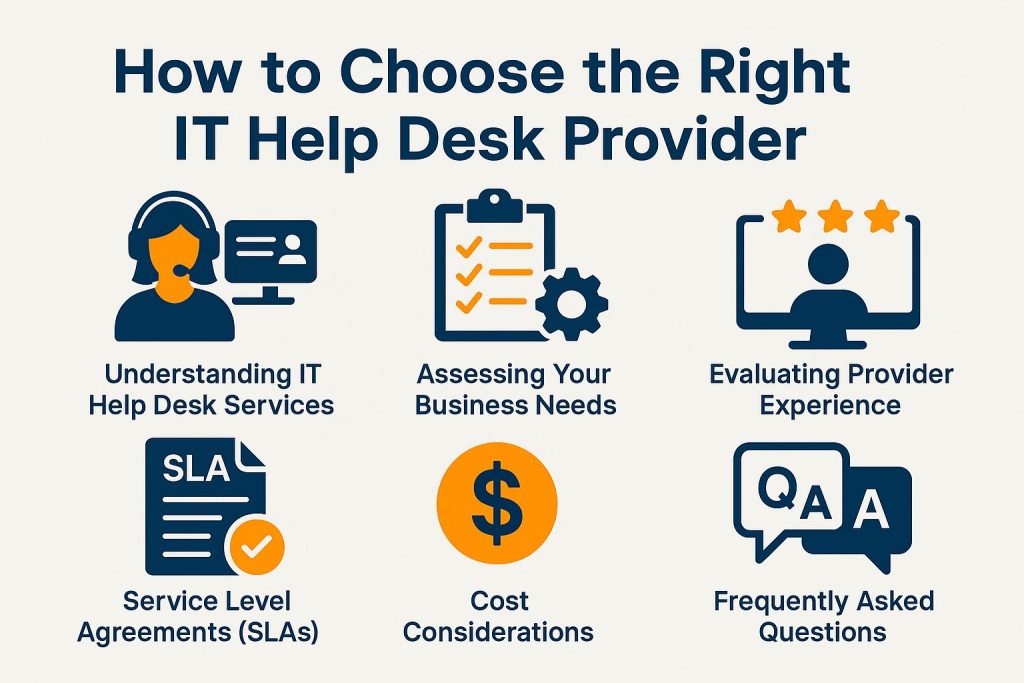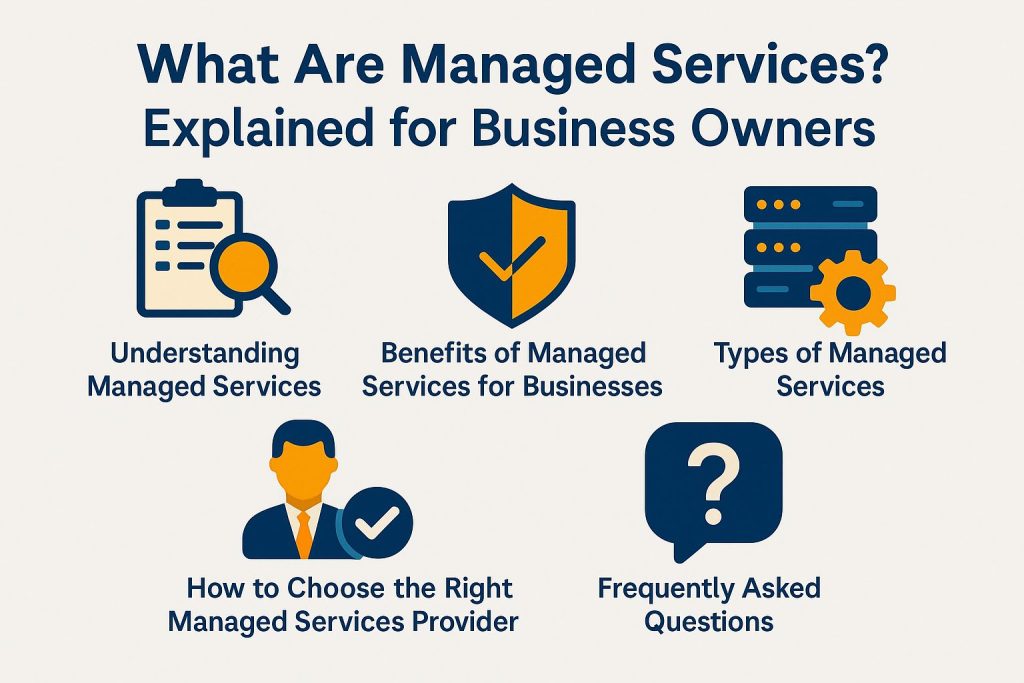IT Help Desk vs Managed Services: What’s the Difference?
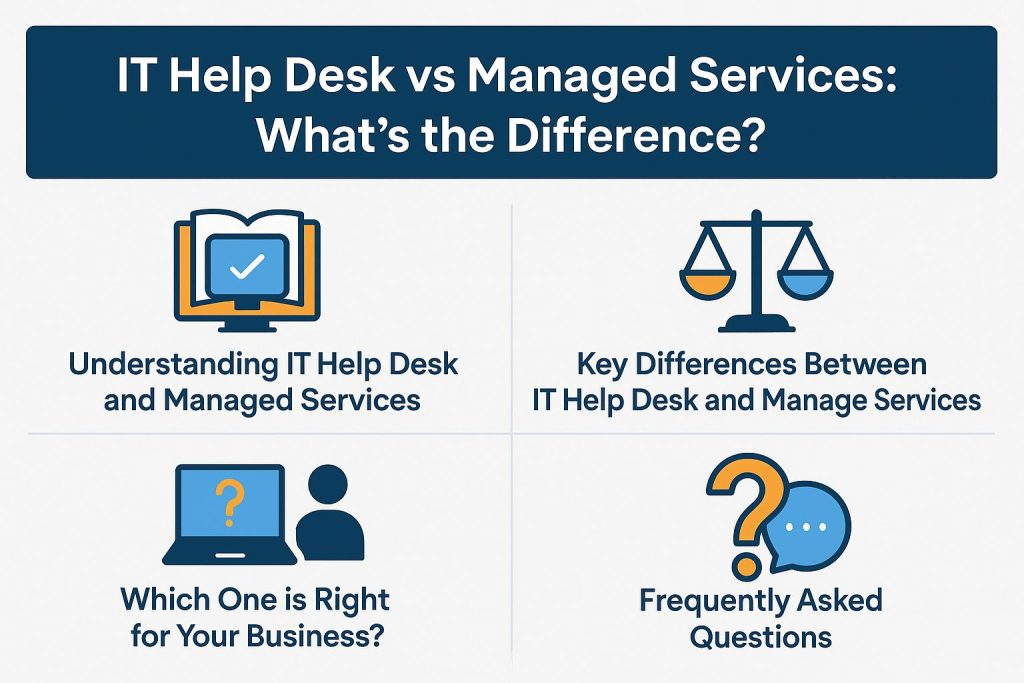
Today, businesses often evaluate IT help desk support and managed services. It is essential to understand the differences between these options to meet an organization’s technology needs. This article defines each service. It highlights key differences in scope, cost, and expertise. It helps readers choose the best solution for their business goals. By the conclusion, readers will be equipped to make an informed decision tailored to their specific circumstances.
Understanding IT Help Desk and Managed Services
The IT Help Desk and Managed Services are vital for today’s IT infrastructure. They provide essential technical assistance and support to businesses of all sizes. Service level agreements (SLA) can help define the expectations for both.
Both aim to improve IT performance and efficiency. However, they differ in scope, service delivery, and goals, including user assistance and troubleshooting methods.
The IT Help Desk focuses on immediate user support and incident management. It uses service desk software. Managed Services provide comprehensive IT solutions that include proactive support, remote management, and strategic IT governance to ensure business continuity and compliance, encompassing aspects like IT operations and risk management.
Recognizing these distinctions helps organizations align their IT strategies with their needs, considering factors like service continuity and endpoint management.
Key Differences Between IT Help Desk and Managed Services
Understanding the key differences is essential for businesses that want to improve their IT capabilities and optimize resources.
The IT Help Desk primarily focuses on addressing immediate user issues and providing reactive support through ticketing systems. In contrast, Managed Services include a wider range of solutions, such as proactive support, system integration, and IT strategy development.
This distinction influences various aspects: the scope of services, cost and payment structures, and flexibility and customization options available for organizations aiming to improve operational efficiency and customer satisfaction.
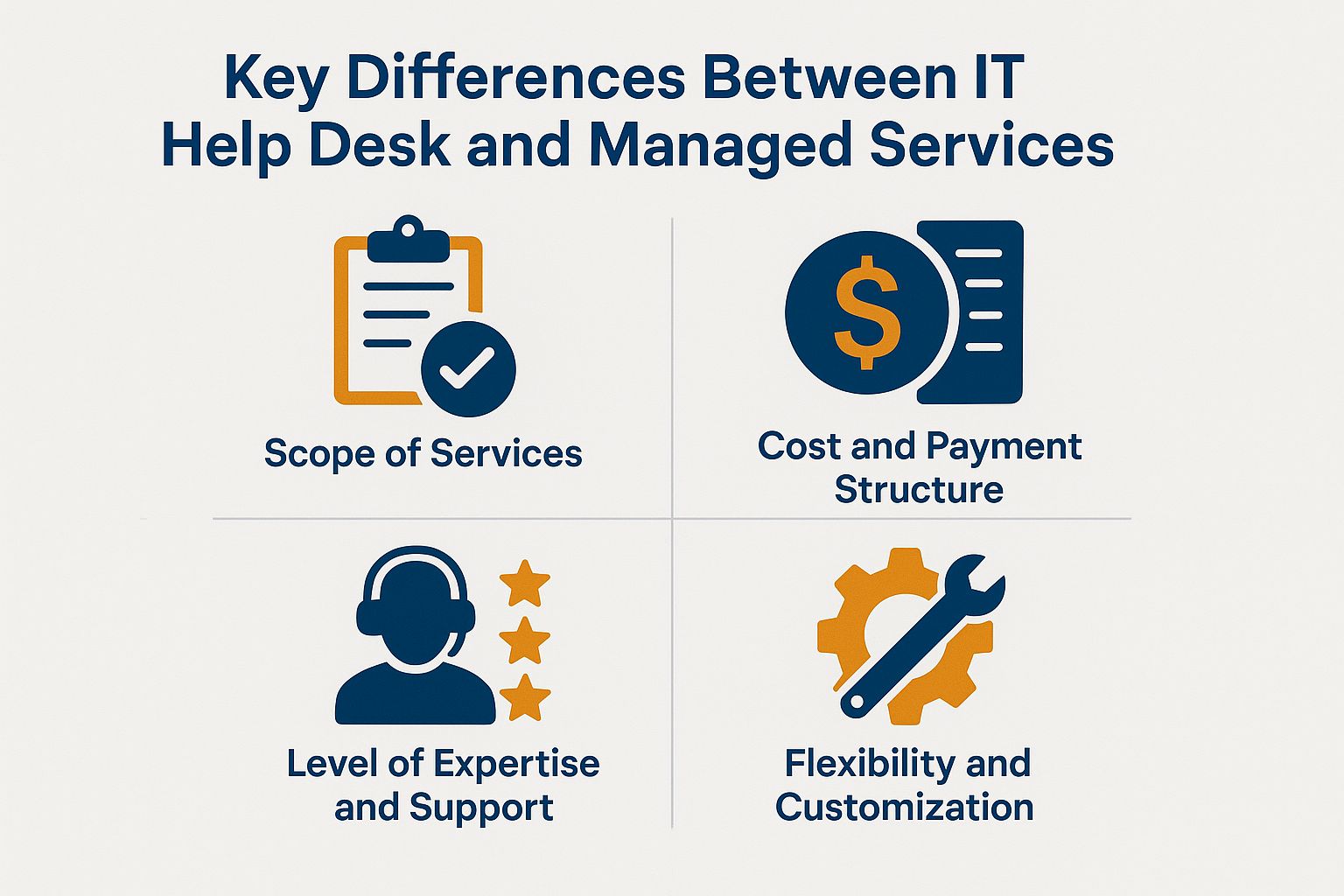
Scope of Services
The scope of services provided by IT Help Desk and Managed Services is distinct, significantly influencing how businesses manage their IT support requirements. IT Help Desk services primarily focus on direct user support for troubleshooting and incident management, addressing immediate technical issues and ensuring operational uptime.
In contrast, Managed Services offer a broader array of IT solutions, including proactive support, systems monitoring, vendor management, and network security, which are essential for maintaining the overall health of IT infrastructure.
Many organizations see incident management in Help Desk services as vital. It allows for quick resolution of disruptions, helping employees stay productive and reducing downtime. User support emphasizes personalized assistance, ensuring that individuals can effectively navigate technical challenges.
On the other hand, Managed Services take a more strategic approach to IT resource management, employing best practices to streamline processes and enhance system performance. This approach includes continuous system monitoring. It identifies potential issues before they escalate, as well as implementing proactive measures to strengthen the stability and security of the IT environment.
These offerings help organizations align their technology goals with business objectives, optimizing both efficiency and effectiveness. For a deeper understanding of how Managed Services can benefit businesses, explore our deep dive into the strategic advantages for Asheville businesses.
Cost and Payment Structure
The cost and payment structure of IT Help Desk and Managed Services can significantly impact an organization’s IT budget and financial planning, influencing decisions around outsourcing and managed IT services.
IT Help Desk services are cost-effective. They provide immediate, reactive support, typically charging per incident or through a subscription. In contrast, Managed Services involve a fixed monthly fee. This model provides cost efficiency and predictable budgeting by covering a broader range of services, including proactive support and IT maintenance.
This distinction in financial models is crucial for understanding how these services affect overall IT investment. With an IT Help Desk, costs can fluctuate based on incidents, leading to unpredictable monthly expenditures. Managed Services, with their fixed-rate model, ensure stability. This helps organizations allocate funds more effectively.
By opting for managed services, companies can reduce unforeseen expenses. This is due to minimized downtime and emergency repairs. Ultimately, this enhances service quality and optimizes the IT budget (our importance of managed IT services for Asheville businesses explains further).
Level of Expertise and Support
The level of expertise and support provided by IT Help Desk and Managed Services represents a fundamental difference that significantly impacts user experience, customer service, and overall satisfaction.
IT Help Desk teams address immediate technical issues. Managed Services offer higher-level IT consulting, including strategic guidance. This aligns IT strategy with business objectives.
This distinction is crucial for daily operations. It influences the speed and effectiveness of addressing technical challenges.
For instance, while the Help Desk focuses on troubleshooting software or hardware, Managed Services evaluate long-term IT infrastructure and implement best practices. This proactive approach ensures immediate assistance and access to training and resources designed to promote self-sufficiency.
The differing levels of expertise shape the quality of support. This results in enhanced productivity and a more satisfying user experience.
Flexibility and Customization
Flexibility and customization are vital for distinguishing IT Help Desk from Managed Services. IT Help Desk services provide standardized immediate support. Managed Services offer scalable solutions customized to align with evolving business strategies, including system administration.
This adaptability helps companies manage diverse IT assets. As operational demands shift, support frameworks adjust to new technologies, enhancing customer experience.
For example, with Managed Services, businesses can integrate advanced service management tools. These tools streamline support and enhance operational efficiency.
As organizations grow or change direction, they can modify IT solutions. This alignment with current objectives maximizes productivity and minimizes downtime.
Ultimately, this level of customization enables businesses to thrive in a competitive landscape.
Which One is Right for Your Business?
Determining the right service for a business requires evaluating various factors. These include service reporting, endpoint management, and knowledge base usage. For businesses looking to optimize costs, smart IT outsourcing can be an effective strategy that aligns with operational efficiency and budget constraints.
Each option has its benefits and drawbacks. These affect operational efficiency, response time, and customer satisfaction objectives.
By assessing support needs, budget constraints, and long-term IT strategy, decision-makers can optimize IT resources. This enhances user experience and ensures effective workforce management.
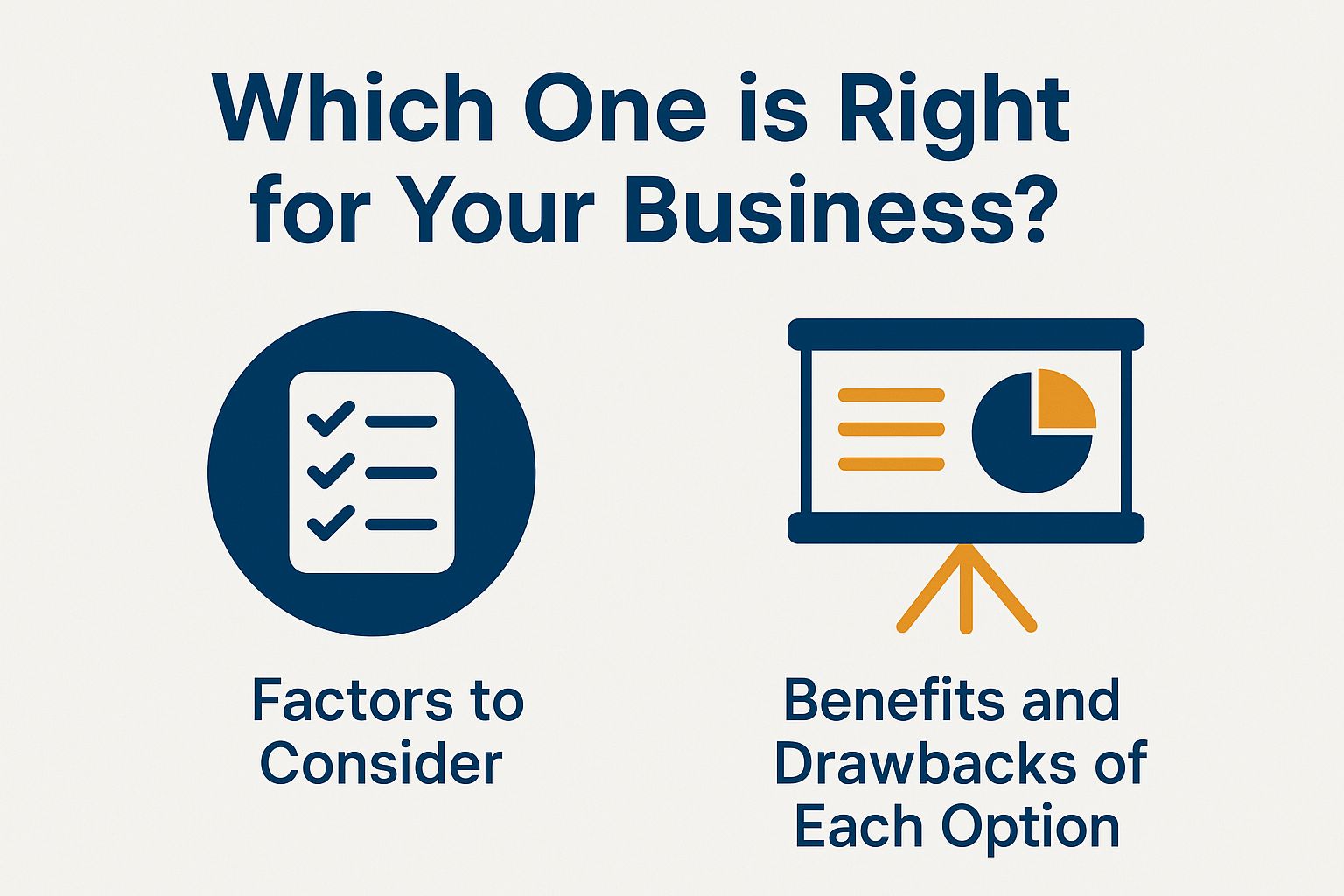
Factors to Consider
Organizations must carefully evaluate IT Help Desk services and Managed Services. They need to ensure that the selected solution matches their IT infrastructure and operational goals.
Key considerations include the size and complexity of the IT environment. Also, consider the number of user support requests and any need for specialized technical expertise.
Organizations should assess their current IT setup. A strong infrastructure may benefit more from managed services, which offer proactive monitoring and maintenance. Businesses with fewer user queries might find that an IT Help Desk provides enough support without extra costs.
The complexity of IT resources is also important. Environments needing advanced security or compliance may require managed services for better management of these challenges.
The decision should be based on a careful evaluation of these factors. This helps organizations make informed choices that boost productivity and response times.
Benefits and Drawbacks of Each Option
Evaluating the pros and cons of IT Help Desk and Managed Services helps organizations improve their IT support. IT Help Desk services provide quick access to technical support and efficient problem-solving, which boosts customer satisfaction.
Managed Services offer complete IT solutions with proactive support and governance, including service level agreements (SLA) and remote options. However, this comes with higher costs and commitments.
This analysis is relevant as businesses align IT performance with operational needs. While IT Help Desks can provide quick fixes, their capacity may be limited during busy times, leading to potential service delays.
Managed Services offer consistent support, proactive monitoring, maintenance, and disaster recovery planning to prevent issues before they occur.
Investing in Managed Services may challenge budgets. Organizations must evaluate their resources and long-term IT strategies carefully. This evaluation is key to improving customer satisfaction, operational efficiency, scalability, and cost-effectiveness.
Frequently Asked Questions
What is the difference between IT Help Desk and Managed Services?
IT Help Desk and Managed Services are both essential for IT support. However, they differ in scope and approach. The Help Desk addresses specific issues using ticketing systems. Managed Services take a proactive, holistic approach to managing IT infrastructure.
What services are included in IT Help Desk support?
IT Help Desk services typically include troubleshooting hardware and software issues, password resets, and basic technical support, along with user training and incident resolution. The Help Desk is reactive, responding to issues as they arise.
What services are included in Managed Services?
Managed Services take a comprehensive, proactive approach to managing IT infrastructure. This includes network management, cybersecurity, and asset management. Services can include network monitoring, system upgrades, data backup, software updates, and security management. Managed Services often include a team of IT professionals for ongoing support.
What are the benefits of using an IT Help Desk?
An IT Help Desk is a valuable resource. It provides quick, effective technical support for specific issues, following ITIL best practices. This helps minimize downtime and keeps systems running smoothly, improving user satisfaction and communication. A Help Desk also allows internal IT staff to focus on strategic initiatives.
What are the benefits of using Managed Services?
Using Managed Services has many benefits. They provide proactive support for IT infrastructure, helping organizations stay ahead of issues.
Managed Services proactively manage an organization’s IT infrastructure. They enhance service integration and automate workflows. This improves system reliability and performance. It also saves costs over time through effective IT budget management and vendor evaluation. Additionally, Managed Services give access to specialized IT experts and advanced technology. They support multi-vendor environments and diverse technology stacks.
Can an organization use both IT Help Desk and Managed Services?
Yes, many organizations combine IT Help Desk and Managed Services for IT support. This balances internal IT teams with managed services. The Help Desk handles daily technical issues, user feedback, and problem management. Managed Services take a proactive approach to managing and maintaining IT infrastructure. This combination offers the best of both worlds for organizations seeking efficient IT support. It integrates change management and application support.
